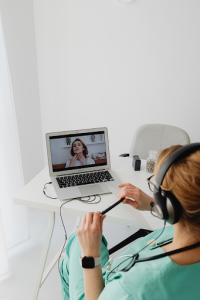 Technology has given us many advantages over the last few decades, says Marla Ahlgrimm. For those of us with disabilities or who can’t leave the house because of transportation or other concerns, telemedicine is one that has made the biggest impact. However, it’s not for everyone, and there are plenty of pros and cons to consider before you pick up the phone and hop on a video call.
Technology has given us many advantages over the last few decades, says Marla Ahlgrimm. For those of us with disabilities or who can’t leave the house because of transportation or other concerns, telemedicine is one that has made the biggest impact. However, it’s not for everyone, and there are plenty of pros and cons to consider before you pick up the phone and hop on a video call.
Pros
Cost Efficiency
Telemedicine is cost-efficient for both healthcare providers and patients. Marla Ahlgrimm explains that the average doctor’s visit can actually cost you $40 or more just in lost time. That doesn’t include your actual medical bill. Telehealth requires no wait and no drive time. Your insurance may cover it and, even if you are self-insured, it might be less expensive than going to a brick-and-mortar doctor’s office.
Engagement
One of the best parts about telemedicine is that your doctor is there for you when you need them. This means that you can engage with them on your terms. Marla Ahlgrimm explains that being able to get in touch with your doctor when it’s convenient for you means that you’re likely to be more open about your health problems. Further, you won’t feel as rushed.
Ease Of Access
The greatest benefit of telemedicine is how easy it is to access. Marla Ahlgrimm explains that if you have a mild cold, suffer from issues such as migraines or UTIs, or need help reading lab or x-ray results, you can do so instantaneously.
Cons
Provider Access
While there are many doctors and pharmacists that offer virtual services, yours may not. Marla Ahlgrimm says that you should have a conversation with your healthcare provider to find out if they do offer telemedicine services. This is important if you’re comfortable with your current provider and don’t wish to discuss your problems and rehash your history with someone else.
Regulatory Barriers
Some providers choose to forgo telemedicine because of a lack of regulation in privacy. Another potential barrier or industry guidelines in some states that may preclude practitioners from using telemedicine in all instances.
Limited Exam Capabilities
Marla Ahlgrimm says a telemedicine doctor can help to diagnose many conditions. Unfortunately, if you have something that deviates from outside the norm or needs a hands-on approach, telemedicine may not be a viable option.
Technology
The vast majority of smartphones and computers with a web cam can handle telemedicine phone calls, which are similar to online meetings. But that does not mean that everyone has these capabilities. Marla Ahlgrimm says that many older people do not have or are not comfortable using technology to access their healthcare.
Is VR The Future Of Telemedicine?
 Most of us are familiar with the idea of a metaverse. Healthcare may also soon jump onto the virtual reality bandwagon. Marla Ahlgrimm explains that there are currently many different healthcare companies looking into the viability of virtual reality in a healthcare setting. These visits may include talking to a doctor in a virtual chat room.
Most of us are familiar with the idea of a metaverse. Healthcare may also soon jump onto the virtual reality bandwagon. Marla Ahlgrimm explains that there are currently many different healthcare companies looking into the viability of virtual reality in a healthcare setting. These visits may include talking to a doctor in a virtual chat room.
According to Marla Ahlgrimm, medicine is still personal. And although she believes that nothing can entirely replace an in-person doctor visit, there are times when telemedicine may come in handy. It’s not a perfect system, but it may be a great option for homebound individuals to get treatment of minor issues that don’t require a full physical examination.













 Marla Ahlgrimm has co-authored two ground-breaking books,
Marla Ahlgrimm has co-authored two ground-breaking books,